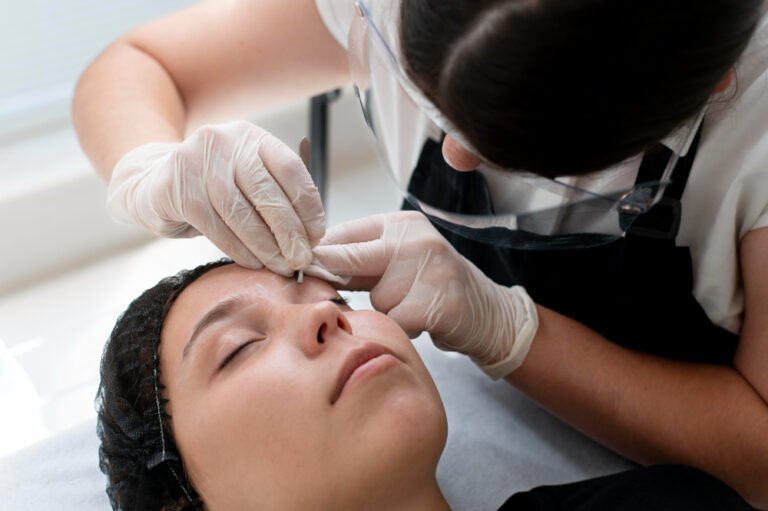Polycystic Ovary Syndrome (PCOS) is one of the leading causes of female infertility, affecting an estimated 1 in 10 women of reproductive age. Characterized by hormonal imbalances and irregular ovulation, PCOS can make it more difficult to conceive—but with the right diagnosis and treatment, many women with PCOS go on to have healthy pregnancies.
In this guide, we’ll explain what PCOS is, how it affects fertility, and how a fertility workup plays a crucial role in diagnosing and managing it.
What Is PCOS?
Polycystic Ovary Syndrome (PCOS) is a hormonal disorder that affects how the ovaries function. Women with PCOS often experience:
- Irregular or absent ovulation
- Excess androgen (male hormone) levels
- Polycystic ovaries (multiple small cysts seen on ultrasound)
PCOS is a syndrome, meaning it’s a collection of symptoms rather than one single identifiable disease. Not every woman with PCOS will have all symptoms.
How PCOS Affects Fertility
Ovulation issues are the primary way PCOS interferes with conception. Without regular ovulation, it becomes harder to predict the fertile window—or to release an egg at all.
PCOS-related fertility challenges include:
- Irregular or absent menstrual cycles (makes timing intercourse difficult)
- Anovulation (no egg is released, so pregnancy can’t occur)
- Poor egg quality in some cases
- Elevated LH levels (disrupts the delicate hormonal balance for ovulation)
- Insulin resistance, which worsens hormonal imbalance
- Increased miscarriage risk (possibly due to hormonal or metabolic factors)
Symptoms That May Point to PCOS
If you’re experiencing any of the following symptoms, a fertility workup can help determine if PCOS is the underlying cause:
- Irregular periods (less than 8 per year)
- Difficulty conceiving after 6–12 months of trying
- Excess facial or body hair (hirsutism)
- Persistent acne or oily skin
- Weight gain, especially around the abdomen
- Thinning hair or hair loss from the scalp
- Dark skin patches (acanthosis nigricans)
How a Fertility Workup Helps Diagnose PCOS
A fertility evaluation is a comprehensive set of tests that identifies barriers to conception, including PCOS. Here’s how it works:
1. Detailed Medical History
Your provider will ask about:
- Menstrual cycle frequency and flow
- Weight changes
- Hair growth patterns
- Past pregnancies and miscarriages
- Family history of diabetes or PCOS
2. Hormonal Blood Tests
PCOS often causes characteristic hormone imbalances that can be detected via bloodwork:
| Hormone | What It May Show in PCOS |
|---|---|
| LH/FSH Ratio | Elevated (often >2:1), indicating ovulatory dysfunction |
| Testosterone | High levels suggest excess androgens |
| AMH | Often elevated due to increased follicle count |
| Insulin | May be high, showing insulin resistance |
| Prolactin/TSH | Checked to rule out other hormonal disorders |
🧪 Timing: Most hormones are tested on days 2–5 of your menstrual cycle (if applicable). AMH can be tested anytime.
3. Transvaginal Ultrasound
An ultrasound can reveal polycystic ovaries—enlarged ovaries with a high number of small, immature follicles arranged around the outer edge (often called the “string of pearls” appearance).
📌 Note: Having polycystic-looking ovaries does not confirm PCOS unless combined with irregular periods and/or excess androgens.
4. Other Tests
To rule out similar conditions or assess fertility potential:
- Glucose tolerance test (checks for insulin resistance)
- Thyroid function test (hypothyroidism can mimic PCOS)
- Semen analysis (to evaluate the male partner)
- Endometrial thickness check (via ultrasound, especially in irregular cycles)
How PCOS Is Diagnosed
To be diagnosed with PCOS, a woman must meet at least 2 out of the 3 Rotterdam criteria:
- Irregular or absent ovulation
- Clinical or biochemical signs of hyperandrogenism
- Polycystic ovaries on ultrasound
This means you can be diagnosed with PCOS even if your ovaries look normal—or have polycystic ovaries without having PCOS.
Managing PCOS-Related Infertility: Treatment Options
Once PCOS is confirmed, your doctor will recommend a treatment plan tailored to your specific symptoms, goals, and hormone levels.
✅ Lifestyle Changes (First-Line for Many)
- Weight loss of just 5–10% can restore ovulation
- Low-glycemic, anti-inflammatory diet
- Exercise to improve insulin sensitivity
✅ Ovulation Induction Medications
- Letrozole (Femara): First-line medication for inducing ovulation
- Clomiphene citrate (Clomid): Older but still effective for some
- Metformin: Especially useful if insulin resistance is present
✅ Intrauterine Insemination (IUI)
- May be used in combination with ovulation induction
✅ In Vitro Fertilization (IVF)
- Recommended if other treatments fail or if additional factors (like male infertility or blocked tubes) are present
- Pre-treatment with birth control pills may be used to regulate hormones before starting IVF
Monitoring and Adjusting Treatment
Women with PCOS undergoing fertility treatment may need:
- Frequent monitoring with bloodwork and ultrasound
- Dose adjustments of ovulation medications to prevent overstimulation
- Close follow-up to avoid ovarian hyperstimulation syndrome (OHSS)
Final Thoughts
PCOS may present unique fertility challenges, but it is highly manageable with the right diagnostic approach and treatment plan. A thorough fertility workup helps confirm the diagnosis, rule out other conditions, and guide evidence-based treatment. The earlier you identify PCOS and its impact on your fertility, the more options you’ll have to achieve a healthy pregnancy.




